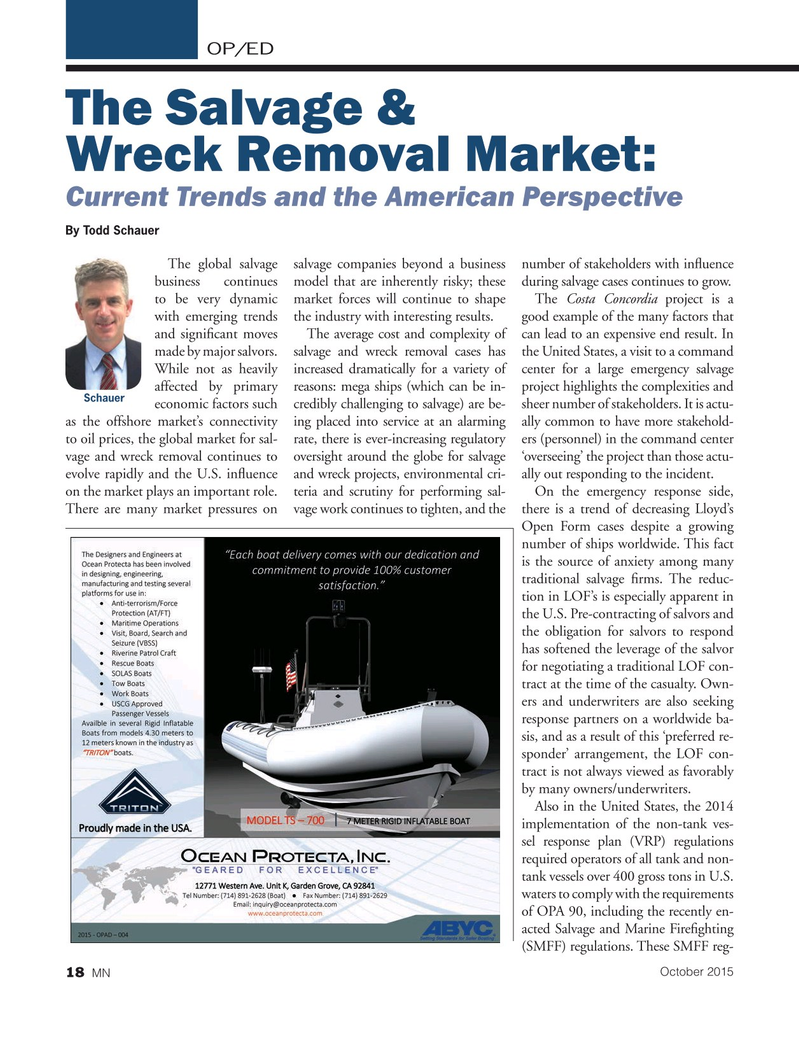
Page 18: of Marine News Magazine (October 2015)
Salvage & Spill Response
Read this page in Pdf, Flash or Html5 edition of October 2015 Marine News Magazine
OP/ED
The Salvage &
Wreck Removal Market:
Current Trends and the American Perspective
By Todd Schauer
The global salvage salvage companies beyond a business number of stakeholders with in? uence business continues model that are inherently risky; these during salvage cases continues to grow.
to be very dynamic market forces will continue to shape The Costa Concordia project is a with emerging trends the industry with interesting results. good example of the many factors that and signi? cant moves The average cost and complexity of can lead to an expensive end result. In made by major salvors. salvage and wreck removal cases has the United States, a visit to a command
While not as heavily increased dramatically for a variety of center for a large emergency salvage affected by primary reasons: mega ships (which can be in- project highlights the complexities and
Schauer economic factors such credibly challenging to salvage) are be- sheer number of stakeholders. It is actu- as the offshore market’s connectivity ing placed into service at an alarming ally common to have more stakehold- to oil prices, the global market for sal- rate, there is ever-increasing regulatory ers (personnel) in the command center vage and wreck removal continues to oversight around the globe for salvage ‘overseeing’ the project than those actu- evolve rapidly and the U.S. in? uence and wreck projects, environmental cri- ally out responding to the incident.
on the market plays an important role. teria and scrutiny for performing sal- On the emergency response side,
There are many market pressures on vage work continues to tighten, and the there is a trend of decreasing Lloyd’s
Open Form cases despite a growing number of ships worldwide. This fact is the source of anxiety among many traditional salvage ? rms. The reduc- tion in LOF’s is especially apparent in the U.S. Pre-contracting of salvors and the obligation for salvors to respond has softened the leverage of the salvor for negotiating a traditional LOF con- tract at the time of the casualty. Own- ers and underwriters are also seeking response partners on a worldwide ba- sis, and as a result of this ‘preferred re- sponder’ arrangement, the LOF con- tract is not always viewed as favorably by many owners/underwriters.
Also in the United States, the 2014 implementation of the non-tank ves- sel response plan (VRP) regulations required operators of all tank and non- tank vessels over 400 gross tons in U.S. waters to comply with the requirements of OPA 90, including the recently en- acted Salvage and Marine Fire? ghting (SMFF) regulations. These SMFF reg-
October 2015 18
MN
MN Oct15 Layout 18-31.indd 18 9/21/2015 11:08:13 AM

 17
17

 19
19
